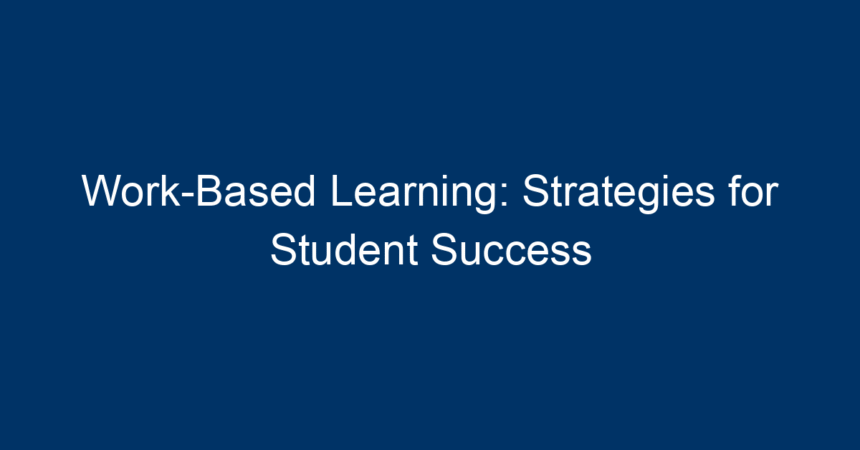In today’s rapidly evolving job market, traditional education pathways are often not enough for students to thrive. Enter work-based learning (WBL)—an educational approach that immerses students in real-world job experiences, integrating academic knowledge with practical skills. This article delves into effective strategies for implementing work-based learning programs, fostering student success, and equipping learners with the tools necessary to thrive in their chosen fields.
What is Work-Based Learning?
Work-based learning is a hands-on teaching method that connects classroom instruction with on-the-job experiences. It enables students to gain invaluable insights into their future careers while developing competencies that are essential in the workplace. From internships and apprenticeships to cooperative education and job shadowing, work-based learning encompasses various formats, all designed to enhance student engagement and employment readiness.
The Importance of Work-Based Learning
The significance of work-based learning cannot be overstated. Here are a few key benefits:
- Skill Development: Students gain practical skills that are often not addressed in traditional education settings.
- Networking Opportunities: WBL provides students with connections in their desired field, fostering professional relationships that could lead to employment.
- Enhanced Employability: Employers increasingly prefer candidates with real-world experience, making WBL an attractive addition to a student’s resume.
- Improved Academic Performance: Engaging in WBL can motivate students, leading to better grades and a higher likelihood of graduation.
Strategies for Successful Work-Based Learning Programs
1. Establish Partnerships with Local Businesses
Creating partnerships with local businesses is one of the most effective strategies for a successful work-based learning program. Schools should collaborate with industries that align with their students’ career interests. This can involve:
- Identifying Potential Partners: Researching local organizations to find those that share a commitment to student development.
- Mutual Benefit: Ensuring that partnerships provide value to both students and businesses, such as skill development for students and fresh perspectives for employers.
2. Integrate with Curriculum
To maximize the effectiveness of work-based learning, it’s essential to integrate these experiences with the academic curriculum. Here’s how:
- Link Theory to Practice: Ensure that lessons learned in the classroom can be applied during work placements. For example, students studying marketing could work in a marketing department to apply their theoretical knowledge.
- Reflection Activities: Encourage students to reflect on their experiences through essays, presentations, or discussions that tie back to classroom learning.
3. Provide Support and Guidance
Students entering the workforce for the first time may feel overwhelmed. Providing adequate support mechanisms is crucial:
- Mentorship Programs: Pair students with mentors who can guide them through their work-based learning experiences, offering advice and encouragement.
- Workshops and Training: Organize sessions that prepare students for the workplace, covering topics like resume writing, interview techniques, and professional communication.
4. Foster a Culture of Collaboration
Encouraging collaboration among students, educators, and employers creates a supportive environment that enhances the work-based learning experience:
- Team Projects: Implement team-based projects that mimic real-world scenarios, allowing students to work together and learn from one another.
- Employer Engagement: Involve employers in the classroom through guest lectures, panel discussions, and co-designing aspects of the curriculum.
5. Utilize Technology
Leverage technology to enhance the work-based learning experience:
- Online Platforms: Use digital tools to connect students with employers, facilitating remote internships or virtual shadowing opportunities.
- Career Portfolios: Encourage students to create digital portfolios showcasing their work-based learning experiences, skills, and accomplishments.
Measuring Success in Work-Based Learning
Evaluating the effectiveness of work-based learning programs is essential for continuous improvement. Employ the following strategies to measure success:
1. Set Clear Objectives
Establish clear educational and career objectives for students participating in work-based learning. This could include:
- Skills Acquisition: Specific skills students should develop during their experience.
- Career Readiness: Assessing students’ preparedness for the job market upon completion of the program.
2. Collect Feedback
Regular feedback from students, employers, and educators is invaluable for assessing the success of WBL initiatives. Methods include:
- Surveys and Interviews: Conduct surveys or interviews with participants to gather insights on their experiences.
- Performance Assessments: Evaluate students based on their work performance, engagement, and skill development.
3. Track Outcomes
Monitor and analyze outcomes related to student success, including:
- Employment Rates: Tracking the percentage of students who secure jobs after completing work-based learning experiences.
- Academic Performance: Analyzing how participation in WBL affects students’ grades and retention rates.
Overcoming Challenges in Work-Based Learning
While work-based learning offers numerous benefits, challenges can arise. Here are strategies for overcoming common obstacles:
1. Limited Resources
- Funding Initiatives: Seek grants or community support to fund work-based learning programs and provide necessary resources.
- Leverage Community Resources: Collaborate with local organizations that can offer support, such as transportation or materials.
2. Employer Hesitance
- Education and Awareness: Educate employers on the benefits of hiring interns and the value they can bring to their organizations.
- Pilot Programs: Start small with pilot programs that allow businesses to test the waters before committing fully.
3. Student Readiness
- Pre-WBL Training: Provide workshops or courses that prepare students for the workplace, improving their readiness for real-world experiences.
- Individualized Support: Offer personalized support tailored to the needs and skills of each student, ensuring they feel confident entering the workplace.
Conclusion: Embracing Work-Based Learning for Future Success
Work-based learning is an incredibly effective strategy in equipping students for the complexities of the modern workforce. By fostering partnerships with local businesses, integrating academic coursework, providing robust support, and leveraging technology, educational institutions can create enriching WBL programs that prepare students for success.
As educators and administrators, embracing these strategies not only enhances student learning but also builds a strong foundation for future generations to thrive in their careers. Ultimately, investing in work-based learning is investing in a brighter future for students, businesses, and society as a whole.
Actionable Insights
- Establish local industry partnerships now to start designing work-based learning experiences.
- Integrate WBL into your curriculum to reinforce practical applications of academic concepts.
- Measure and assess the effectiveness of your programs continuously to ensure improvements.
- Train and prepare students properly to navigate real-world work environments effectively.
Embrace the transformative power of work-based learning today and set your students on the path to success!




